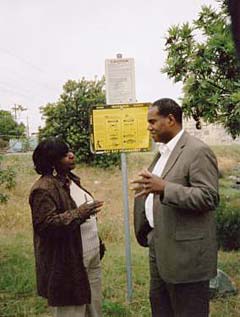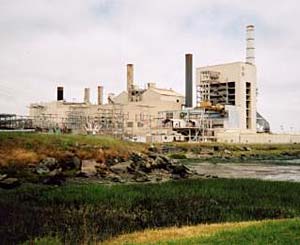Following the Toxic Trail
Air Date: Week of June 3, 2005

Marie Harrison, Greenaction organizer, and Steve Curwood in front of fish warning signs at the power plant at Bayview Hunter's Point. (Photo: Eileen Bolinsky)
Marie Harrison takes Living on Earth host Steve Curwood on a "toxic tour" of her old neighborhood, Bayview Hunters Point in southeast San Francisco. It's not only home to mostly poor people of color, but also, to two power plants, the city's sewage treatment facility, a naval shipyard declared a Superfund site, and many industrial companies.
Transcript
HARRISON: This is actually one of the oldest sections of Bayview Hunters Point right here. This is Evans. The next major street is Third. At the opposite end would be Cesar Chavez. And what’s important about this main run is that this used to be the very main run for heavy trucks, a lot of diesels.
[sitting in the car]
CURWOOD: A block at a time, Marie Harrison points out the industries that line the streets of Bayview Hunters Point, in southeast San Francisco. A mother and a grandmother, and now a community organizer, Ms. Harrison grew up in this neighborhood of African Americans, Pacific Islanders, and the four single largest sources of air pollution in San Francisco.
|
HARRISON: In Bayview Hunters Point one of the biggest problems we have is we have contaminated soil, we have water that has more pollution in it, more garbage in it than anybody should allow anywhere. We have air that you can cut with a knife because at certain times of the year there’s so much junk in our air, it’s ridiculous. CURWOOD: On one block there's a metal rendering factory. Down the street, a company that makes the coating for baking pans. A whiff of the air hints of what's to come. HARRISON: At this corner starts the Southeast sewage treatment plant. This plant goes down to the end of the block. It goes in one, two, three, almost three normal blocks and three blocks down, it backs up to the Southeast Community College, as you go down Phelps Street. It’s a very large place. CURWOOD: With some very large neighbors, including a naval shipyard that's a Superfund site, and two coal-fired power plants. Marie Harrison used to live in a housing project across the street from Hunter's Point power plant, where residents, including her own family, suffered health problems ranging from asthma to cancer. HARRISON: My son was constantly breaking out with some kind of rash at the bend of his legs and around his neck. My baby daughter would break out with a rash all over the muscle tissue of her leg and she would scratch and scratch and scratch it. CURWOOD: Their doctor said the kids would grow out of it but her daughter, who's 32 now, still suffers from skin rashes. Health Department officials told residents - especially African Americans-- that they should exercise more, and watch their diets. Over time, folks like Marie Harrison began to think the problem was not due to their lifestyle or their race. HARRISON: We begin to notice that the people who moved in and the people who were here, and not necessarily African American folks, but people who moved into our community I guess anywhere between five to ten years, they started having children here, their children were either born with asthma, some type of heart disease or some type of bronchial something going on. There was always something. CURWOOD: A neighboring family who watered their vegetable garden from well water later found out the water contained arsenic, and the company responsible didn't tell residents about it. Over the years, Ms Harrison says that whole family developed one form of cancer or another. But one event involving her grandson, Roman, changed Marie Harrison's life forever. HARRISON: They lived across the street from the power plant…and his bedroom window, this is the highest point of stoke for the power plant…he always had to keep it cracked. But every morning, he’d wake up with blood all over his pillow. CURWOOD: Then one day, the nosebleed turned into an emergency. HARRISON: Oh God, when Roman was, he wasn’t quite five, my daughter called me in a panic. The ambulance hadn’t got there. First I said I asked her, did you clean the blood around his nose? She said yes but he still couldn’t breathe. He was really tiny and he was screaming. By the time I got there the ambulance was there and they were trying to make him comfortable. CURWOOD: The doctor at the hospital was reluctant to put Roman in an oxygen tent, Marie Harrison believes, because it’s expensive and the family was on Medicare. When she pressed the doctor for solutions to her grandson's health problems, he said bluntly: move him out of the neighborhood. And that’s just what Marie Harrison did, but not before making a promise to herself.  Marie Harrison, Greenaction organizer, and Steve Curwood in front of fish warning signs at the power plant at Bayview Hunters Point. (Photo: Eileen Bolinsky) |
HARRISON: Somewhere in that time I made up my mind that not only was Roman not going to have to go through this but nobody’s child. CURWOOD: Now Marie Harrison is a community organizer for Green Action for Health and Environmental Justice in the Bay Area. She organizes rallies, phone calling, and letter-writing campaigns, toxic tours for the public, and she goes into classrooms to educate children. Her main goal is to shut down the polluting power plant, but that's just a start. HARRISON: We know for a fact that this plant plays a big part of the picture but we know that it’s not the only source of our ills and, shall I say, our misdeeds. And we know that any person here will say that this power plant has got to go, we understand what it’s doing to us, but it’s not the only thing here. We understand that there’s more than one Goliath here. We can only take on one at a time. CURWOOD: For years now, public officials have promised to shut down the plant, only to renege as the deadline approaches. The present mayor of San Francisco, Gavin Newsom, pledges to shut Hunter's Point down in two years. Marie Harrison says she'll believe it when she sees it. Opponents say shutting down the power plant will cost the city too much money. But Ms. Harrison says the city pays either way. HARRISON: It should not, would not, cannot, and we won’t allow it to be, whichever is the cheapest because a lot times when you think about the bottom line the technologies that they use depend on how little it’s gonna cost. Well, if you add up the medical bills for one person who goes into the emergency room how many times a year, the medicine, how many times a year they have to have it refilled, and how many times do they have to call an ambulance to take them to the emergency room. When you start adding up those costs for one person, times how many persons live in our community, times how many people live in the city, wouldn’t it be cheaper to say, you know, there’s gotta be a better way to do this. I can’t be happy until everyone is moved out of harm’s way. Links
|






